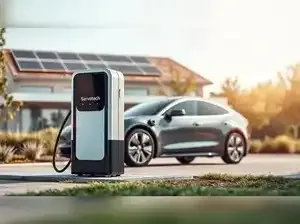
For the next-gen driver, the car won’t be just a machine. It will be a smart device that happens to be on wheels.
That means the battle for market share is shifting from torque specs to tech specs, triggering a feature war.
Automobiles are doing things that once were considered stuff of science fiction. From pothole-dodging AI, radarequipped bikes to flying minivans and cars that talk to your home, to smart watches controlling your EV, these innovations are not just ‘cool’, they’re reshaping the very meaning of mobility. As younger, tech-savvy consumers become a key market, manufacturers are pushing the boundaries of what’s possible inside and around the vehicle.
ET takes a look at some of the coolest, most cutting-edge automotive technologies hitting the road today — both from India and from around the globe.
Ather Energy recently introduced a feature that uses onboard accelerometers and gyroscopes inside its Inertial Measurement Unit (IMU), combined with crowdsourced data from nearly half-a-million riders, to detect potholes and warn riders. Beyond the obvious uses on our roads, such aggregated data collection could help city authorities prioritise road repairs and reduce two-wheeler accidents, especially during India's monsoon season. “Ather vehicles typically have multiple sensors that help us gather rich data. Our pothole detection system uses a machine-learning approach. We have been able to create useful data loops for the benefit of all our riders,” says Swapnil Jain, CTO, Ather Energy .
2. Radar revolutions
Ultraviolette’s X-47 Crossover introduces integrated radar technology on a production motorcycle. The bike features a 77 GHz rear-facing radar that tracks up to 200 metres behind, adjusting its zone dynamically based on speed and riding conditions. The system supports blind-spot detection, lane change assist, overtake alerts and rear collision warnings — with auto-activating hazard lights. Dual 1080p dashcams complete the high-tech safety suite. The idea, the company says, is shifting biking from reactive to predictive safety. “We’ve adapted sensor systems originally developed for aerospace and high-end automotive use and trafficdense city rides, unpredictable highways and everything in between,” says Niraj Rajmohan, CTO, Ultraviolette.
3. EV-smartwatch integration
Meanwhile, TVS Motor Company and wearable tech brand Noise have introduced India’s first EV-smartwatch pairing with the TVS iQube. Riders can monitor battery status, tyre pressure, charging progress and receive alerts, including distance-to-empty, tow/ theft notifications, crash detection and geofencing — all with intuitive colourcoded visuals.
4. In-car UPI payments
Tata Motors and ToneTag have launched India’s first UPI-based in-car payment system, DrivePay, debuting in the upcoming Harrier EV. Integrated into a 14.5-inch QLED infotainment system, users can pay for EV charging, monitor FASTag balances, or activate auto recharges without touching the phone.
XPeng stunned this year’s Consumer Electronics in Las Vegas with the Land Aircraft Carrier — an electric minivan with a foldable eVTOL (electric vertical takeoff and landing) aircraft stored in the rear. The detachable aircraft features autonomous flight and an emergency parachute system that activates at just 50 metres altitude. Priced below $300,000, this sci-fi concept is entering production in 2026.
2. Off-road superpowers
The BYD Yangwang U8 brings extreme torque vectoring with four independent motors — one per wheel — offering tank turns, crab-walking, and even flotation in water for up to 30 minutes. It’s part SUV, part amphibious escape vehicle.
3. Charging in minutes
Zeekr’s new Golden Brick battery with 5.5C ultra-fast charging redefines EV practicality. Using LFP chemistry, it can go from 10% to 80% charge in just 10.5 minutes on Zeekr’s V3 stations — even in cold weather. Over 860 ultra-fast stations are already open in China and the brand is aiming for 10,000 by 2026.
4. Cabin control centre
Xiaomi’s SU7 EV is a control centre for your entire smart home. A 16.1-inch 3K screen, 56-inch HUD and rotating dashboard greets you with a digital welcome. Inside, the SU7 connects with over 1,000 Xiaomi smart devices and supports plug-and-play expansion.
5. Tank turn capability
Mercedes-Benz has turned a legendary off-roader into a technological showpiece. The electric G 580 can spin in place like a tank using four independent electric motors — each wheel turning independently for 360-degree rotation. This ‘G-Turn’ is impossible in traditional combustion vehicles. It allows for nimble manoeuvering in tight or rough spaces — proof that EVs unlock new driving dimensions even for legacy luxury brands.
6. AI mirror adjustment
Vietnamese company VinFast’s MirrorSense is the world’s first AI-powered mirror adjustment system. Using facial recognition and eye-tracking, it automatically adjusts all mirrors with 10 mm accuracy. That means that drivers won’t have to fumble with manual controls, and the system customises views the moment the driver enters.
Wanted: A new kind of automobile engineer
The growing complexity of modern vehicles is posing new challenges in hiring for automakers.
EVs are driving a fundamental shift in how cars are designed and built, allowing manufacturers to integrate and update features far more flexibly than with traditional inter nal combustion engine (ICE) vehicles.
From Advanced Driver Assistance Systems (ADAS) that can be enabled or disabled remotely, to real-time perfor mance upgrades, EVs are offering various levels of customisation.
Chinese auto companies have emerged as global leaders in both hightech electronics and software capabilities and the vehicles now boast features that rival — and in many cases, match — those of luxury German brands, but at a fraction of the price.
In contrast, India is only beginning to accelerate in this direction, having started serious efforts just two to three years ago.
Now, Indian auto OEMs are becoming increasingly aggressive and innovation-driven. But the growing complexity of electronics in modern vehicles is posing new challenges — especially when it comes to hiring and talent development.
Here’s what experts are saying:
“Today’s tech-savvy customer demands connected cars and smart convenience features. After the TV, laptop and phone, the car screen has become the fourth screen in their digital life. They expect the same level of connectivity and seamless experience in their car as they do on their smartphones. This shift is reshaping the auto industry from the inside out. The pressure is now on mid-level management to reinvent themselves and upskill to stay relevant. We’re also seeing a growing trend of car companies hiring fresh tech talent straight out of college to bridge this capability gap.” — Rajeev Chaba, auto industry veteran.
“Skilling is a big challenge. Earlier, companies would hire from traditional engineering colleges. Today, they’re looking for data scientists, AI specialists and people with strong software and electronic systems expertise. The car today is essentially a mobile phone on wheels. They [automakers] want to stand out, offer something unique to customers. The younger generation wants cutting-edge tech and OEMs are responding — creating demand and pushing for greater levels of personalisation.” — Kavan Mukhtyar, leader, automotive, PwC India.
“We have seen surging demand for skills in artificial intelligence, software development, battery technology and data science. Our workforce now needs to be far more multidisciplinary and it’s imperative to continuously upskill to keep ahead of rapid technological changes. Our talent strategy is built on industry-academia collaboration and we have signed MoU with 50+ engineering, diploma and ITI institutions to bridge the skills gap. For our employees, there are regular in-house upskilling and reskilling efforts put in place. These initiatives are complemented by cross-functional rotational assignments that allow traditional automotive engineers and production staff to expand their skillsets and transition into futureready roles within our electric and tech-focused manufacturing streams.” — Yeshwinder Patial, senior director, human resources, JSW MG Motor India.
That means the battle for market share is shifting from torque specs to tech specs, triggering a feature war.
Automobiles are doing things that once were considered stuff of science fiction. From pothole-dodging AI, radarequipped bikes to flying minivans and cars that talk to your home, to smart watches controlling your EV, these innovations are not just ‘cool’, they’re reshaping the very meaning of mobility. As younger, tech-savvy consumers become a key market, manufacturers are pushing the boundaries of what’s possible inside and around the vehicle.
ET takes a look at some of the coolest, most cutting-edge automotive technologies hitting the road today — both from India and from around the globe.
Indian Innovators
1. Pothole alertsAther Energy recently introduced a feature that uses onboard accelerometers and gyroscopes inside its Inertial Measurement Unit (IMU), combined with crowdsourced data from nearly half-a-million riders, to detect potholes and warn riders. Beyond the obvious uses on our roads, such aggregated data collection could help city authorities prioritise road repairs and reduce two-wheeler accidents, especially during India's monsoon season. “Ather vehicles typically have multiple sensors that help us gather rich data. Our pothole detection system uses a machine-learning approach. We have been able to create useful data loops for the benefit of all our riders,” says Swapnil Jain, CTO, Ather Energy .
2. Radar revolutions
Ultraviolette’s X-47 Crossover introduces integrated radar technology on a production motorcycle. The bike features a 77 GHz rear-facing radar that tracks up to 200 metres behind, adjusting its zone dynamically based on speed and riding conditions. The system supports blind-spot detection, lane change assist, overtake alerts and rear collision warnings — with auto-activating hazard lights. Dual 1080p dashcams complete the high-tech safety suite. The idea, the company says, is shifting biking from reactive to predictive safety. “We’ve adapted sensor systems originally developed for aerospace and high-end automotive use and trafficdense city rides, unpredictable highways and everything in between,” says Niraj Rajmohan, CTO, Ultraviolette.
3. EV-smartwatch integration
Meanwhile, TVS Motor Company and wearable tech brand Noise have introduced India’s first EV-smartwatch pairing with the TVS iQube. Riders can monitor battery status, tyre pressure, charging progress and receive alerts, including distance-to-empty, tow/ theft notifications, crash detection and geofencing — all with intuitive colourcoded visuals.
4. In-car UPI payments
Tata Motors and ToneTag have launched India’s first UPI-based in-car payment system, DrivePay, debuting in the upcoming Harrier EV. Integrated into a 14.5-inch QLED infotainment system, users can pay for EV charging, monitor FASTag balances, or activate auto recharges without touching the phone.
Global gamechangers
1. Flying car meets EVXPeng stunned this year’s Consumer Electronics in Las Vegas with the Land Aircraft Carrier — an electric minivan with a foldable eVTOL (electric vertical takeoff and landing) aircraft stored in the rear. The detachable aircraft features autonomous flight and an emergency parachute system that activates at just 50 metres altitude. Priced below $300,000, this sci-fi concept is entering production in 2026.
2. Off-road superpowers
The BYD Yangwang U8 brings extreme torque vectoring with four independent motors — one per wheel — offering tank turns, crab-walking, and even flotation in water for up to 30 minutes. It’s part SUV, part amphibious escape vehicle.
3. Charging in minutes
Zeekr’s new Golden Brick battery with 5.5C ultra-fast charging redefines EV practicality. Using LFP chemistry, it can go from 10% to 80% charge in just 10.5 minutes on Zeekr’s V3 stations — even in cold weather. Over 860 ultra-fast stations are already open in China and the brand is aiming for 10,000 by 2026.
4. Cabin control centre
Xiaomi’s SU7 EV is a control centre for your entire smart home. A 16.1-inch 3K screen, 56-inch HUD and rotating dashboard greets you with a digital welcome. Inside, the SU7 connects with over 1,000 Xiaomi smart devices and supports plug-and-play expansion.
5. Tank turn capability
Mercedes-Benz has turned a legendary off-roader into a technological showpiece. The electric G 580 can spin in place like a tank using four independent electric motors — each wheel turning independently for 360-degree rotation. This ‘G-Turn’ is impossible in traditional combustion vehicles. It allows for nimble manoeuvering in tight or rough spaces — proof that EVs unlock new driving dimensions even for legacy luxury brands.
6. AI mirror adjustment
Vietnamese company VinFast’s MirrorSense is the world’s first AI-powered mirror adjustment system. Using facial recognition and eye-tracking, it automatically adjusts all mirrors with 10 mm accuracy. That means that drivers won’t have to fumble with manual controls, and the system customises views the moment the driver enters.
Wanted: A new kind of automobile engineer
The growing complexity of modern vehicles is posing new challenges in hiring for automakers.
EVs are driving a fundamental shift in how cars are designed and built, allowing manufacturers to integrate and update features far more flexibly than with traditional inter nal combustion engine (ICE) vehicles.
From Advanced Driver Assistance Systems (ADAS) that can be enabled or disabled remotely, to real-time perfor mance upgrades, EVs are offering various levels of customisation.
Chinese auto companies have emerged as global leaders in both hightech electronics and software capabilities and the vehicles now boast features that rival — and in many cases, match — those of luxury German brands, but at a fraction of the price.
In contrast, India is only beginning to accelerate in this direction, having started serious efforts just two to three years ago.
Now, Indian auto OEMs are becoming increasingly aggressive and innovation-driven. But the growing complexity of electronics in modern vehicles is posing new challenges — especially when it comes to hiring and talent development.
Here’s what experts are saying:
“Today’s tech-savvy customer demands connected cars and smart convenience features. After the TV, laptop and phone, the car screen has become the fourth screen in their digital life. They expect the same level of connectivity and seamless experience in their car as they do on their smartphones. This shift is reshaping the auto industry from the inside out. The pressure is now on mid-level management to reinvent themselves and upskill to stay relevant. We’re also seeing a growing trend of car companies hiring fresh tech talent straight out of college to bridge this capability gap.” — Rajeev Chaba, auto industry veteran.
“Skilling is a big challenge. Earlier, companies would hire from traditional engineering colleges. Today, they’re looking for data scientists, AI specialists and people with strong software and electronic systems expertise. The car today is essentially a mobile phone on wheels. They [automakers] want to stand out, offer something unique to customers. The younger generation wants cutting-edge tech and OEMs are responding — creating demand and pushing for greater levels of personalisation.” — Kavan Mukhtyar, leader, automotive, PwC India.
“We have seen surging demand for skills in artificial intelligence, software development, battery technology and data science. Our workforce now needs to be far more multidisciplinary and it’s imperative to continuously upskill to keep ahead of rapid technological changes. Our talent strategy is built on industry-academia collaboration and we have signed MoU with 50+ engineering, diploma and ITI institutions to bridge the skills gap. For our employees, there are regular in-house upskilling and reskilling efforts put in place. These initiatives are complemented by cross-functional rotational assignments that allow traditional automotive engineers and production staff to expand their skillsets and transition into futureready roles within our electric and tech-focused manufacturing streams.” — Yeshwinder Patial, senior director, human resources, JSW MG Motor India.








